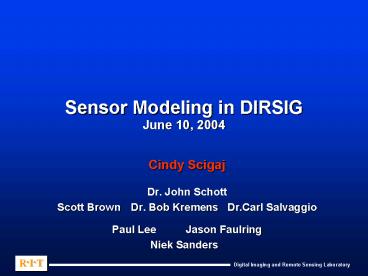Sensor Modeling in DIRSIG June 10, 2004 - PowerPoint PPT Presentation
1 / 17
Title:
Sensor Modeling in DIRSIG June 10, 2004
Description:
Potential systems: AVIRIS, WASP, HYDICE, SEBASS, COMPASS, NVIS ... WASP imagery with supporting ground truth measurements have been acquired and ... – PowerPoint PPT presentation
Number of Views:83
Avg rating:3.0/5.0
Title: Sensor Modeling in DIRSIG June 10, 2004
1
Sensor Modeling in DIRSIGJune 10, 2004
- Cindy Scigaj
- Dr. John Schott
- Scott Brown Dr. Bob Kremens Dr.Carl Salvaggio
- Paul Lee Jason Faulring
- Niek Sanders
2
Overview
- What is DIRSIG?
- Project definition
- Background information
- MTF, Spectral Response ( spectral smile), Noise
- Lab experiments
- Field experiments
- Summary
3
DIRSIG
- Physics based model developed at RIT to simulated
remotely sensed data - Various platforms
- Line scanner, framing array, pushbroom scanner
DIRSIG Megascene Image
4
Project Definition
- Historical perspective and justification
- Users wishing to incorporate rigorous sensor
modeling to DIRSIG simulations needed to
oversample the image spatially and spectrally. - Large intermediate images were required
- Project Goals
- Add a flexible sensor model that allows users to
incorporate sensor models during rendering. - Vary properties for each detector element (pixel)
- Create and distribute pre-built sensor models for
out-of-the-box use. - Potential systems AVIRIS, WASP, HYDICE, SEBASS,
COMPASS, NVIS - Allow users to compare results with these
standardized models - Combine efforts to create sensor model
cook-book - Benefit algorithm developers/testers and
instrument designers - Long term handle tabulated data
- Overall provide an easy way to incorporate
sensor artifacts
5
Implementation Overview
- Response function
- A set of one or more channel or band responses
- Different types of channels
- Pass-band channels have a tabulated spectral
response. - Spectrometers channels have a center, width and
shape. - Both have gain and bias terms per channel
- Dead detectors introduced with zero gain values
- Spectral Response Function
- Pushbroom spectrometer specific issues
- Smile and frown effects can vary channel
locations for each spatial detector. - Point-Spread Function (MTF)
- A combination of atmosphere (turbulence),
platform (jitter), optics, detector and
electronics effects. - Ideally, a series of PSFs stored in a functional
form to ease computation and allow for different
sub-detector sampling schemes. - Noise
- A combination of photon arrival, detector
read-out and electronics. - Store the noise covariance and use a Principle
Component (PC) synthesis method to compute a
unique noise spectrum for each scan/read-out of
the detector elements.
6
Pushbroom Scanners
- AIS (grating)
- HYDICE (prism)
- SEBASS (prism)
- Hyperion (EO-1)
7
Response FunctionSpectral Smile and Frown
- In pushbroom spectrometers, the spectral channel
locations of pixels on the edge of the focal
plane are different than the ones in the center
of the focal plane - This effect can be modeled with these
enhancements.
8
Point-Spread Function
- A spectrally dependent function that introduces
the blur from a variety of sources in the image
formation process. - Atmospheric turbulence, platform jitter, optics,
detector and electronics effects. - Ideally, each of these would be in a flexible,
functional form. - Radially symmetric (Gaussian, Lorentzian, etc.)
- X/Y separable (Gaussian, Sinc, Sinc2, etc.)
- A functional form could allow the user to change
the sub-detector sampling (finer grid, N random
locations, etc.)
PSF PSFa(r,l) PSFp(r) PSFo(r) PSFd(x,y)
Cn2
jitter
optics
detector
Pixel Detector
9
NoiseSpectral Structure
- We want to introduce noise for each detector
element and each scan - Each detector can have unique noise statistics
- Non-repeating noise that can be described by
higher order statistics (spectral
covariance/correlation) - Due to focal plane design (shared electronics)
the sensor noise is correlated. - This effect can be modeled with these
enhancements.
1
2
3
4
AVIRIS Noise Correlation
10
Modeling Concept
- To accurately model the radiance at this pixel
detector - Spectrally oversample
- Convolve to channel resolution using response.
- Spatially oversample inside and outside the
physical detector element - Convolve to detector resolution using PSF.
- Add spectrally correlated noise
- Pull from statistical noise model.
Many spatial samples
Focal Plane
Many spectral samples
PSF Contribution Region
Projected Detector Extent
11
Data Flow
PSF (by channel)
Noise (by channel)
Channel Responses
Apply Response
N Spatial Samples Many Spectral Samples Without
Noise
N Spatial Samples M Spectral Samples Without Noise
1 Spatial Sample M Spectral Samples Without Noise
1 Spatial Sample M Spectral Samples With Noise
12
Wildfire Airborne Sensor Program(WASP)
- System in development at RIT
- Four separate camera systems
- Terra Pix 0.4-0.9 microns
- SWIR 0.9-1.8 microns
- MWIR 3.0-5.0 microns
- LWIR 8.0-9.2 microns
- Characterization
- equipment specifications
- actual lab scenes and measurements
- Bayer pattern artifacts
WASP
13
WASP Modeling Criterion
14
Lab Targets
15
Field Experiments 06/07/04
- Data collected on scene
- GPS location
- ASD radiance
- ASD reflectance
- DP radiance
- Temperature
- Thermocouples
- Exergen
- Thermistors _at_ pier
16
Summary
- Sensor modeling status
- A survey of different sensors has been performed
to gather information on popular imaging
platforms. - This information will be used to construct
distributed sensor models. - Recently became in contact with COMPASS
instrument group - Precal data and calibration documentation
- Correlated noise has been demonstrated
- Simple smile case has been demonstrated
- Goal supply significantly better default sensor
models - These new features, user interfaces and pre-built
sensor models will be in DIRSIG 4 - Experiments status
- WASP Lab data acquisition complete
- Image analysis programs being developed
- using ISO standard procedures
- WASP imagery with supporting ground truth
measurements have been acquired and need to be
sorted and organized - Waiting for SEBASS and COMPASS data distribution
30 days? - Pre-calibrated data as well
17
Contact info
- WASP Terra Pix _at_ 3,000 ft
- Cindy Scigaj
- cls8343_at_cis.rit.edu































